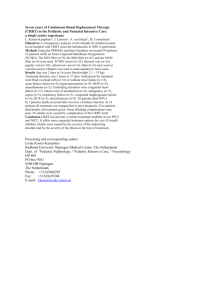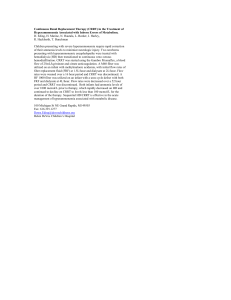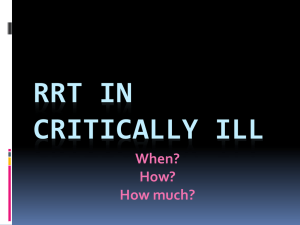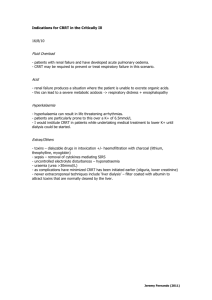Keeping the Balance: Achieving Desired Outcomes with CRRT
advertisement
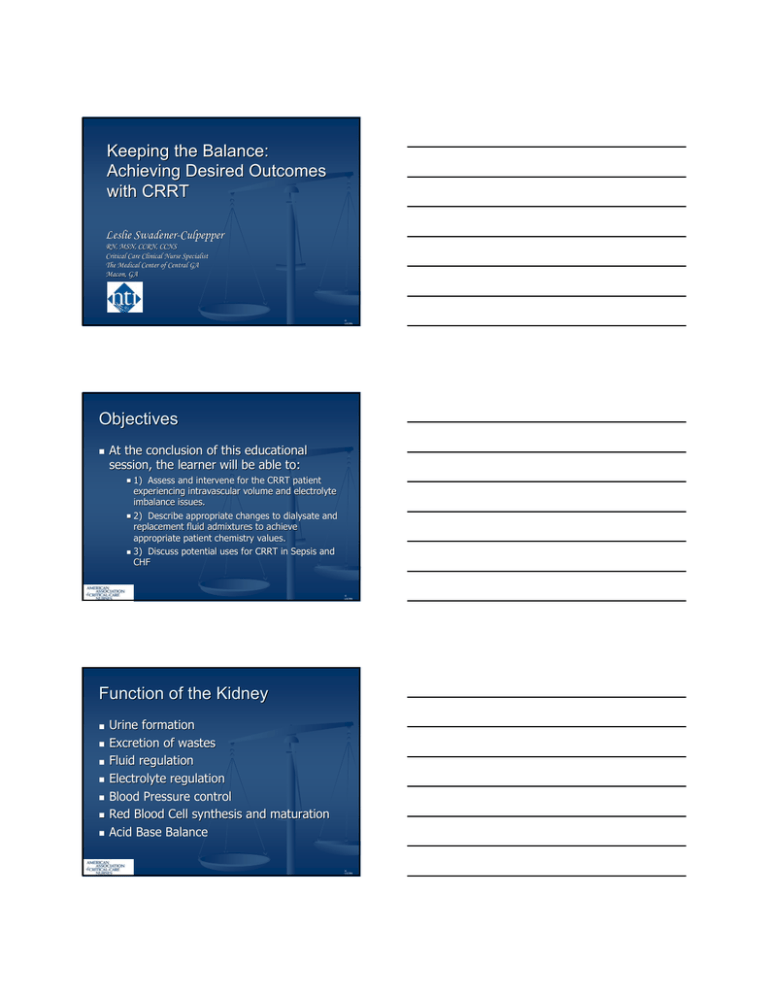
Keeping the Balance: Achieving Desired Outcomes with CRRT Leslie SwadenerSwadener-Culpepper RN, MSN, CCRN, CCNS Critical Care Clinical Nurse Specialist The Medical Center of Central GA Macon, GA © LSCRN Objectives At the conclusion of this educational session, the learner will be able to: 1) Assess and intervene for the CRRT patient experiencing intravascular volume and electrolyte imbalance issues. 2) Describe appropriate changes to dialysate and replacement fluid admixtures to achieve appropriate patient chemistry values. 3) Discuss potential uses for CRRT in Sepsis and CHF © LSCRN Function of the Kidney Urine formation Excretion of wastes Fluid regulation Electrolyte regulation Blood Pressure control Red Blood Cell synthesis and maturation Acid Base Balance © LSCRN Renal Failure Pre Renal Intra Renal Post Renal © LSCRN Renal Failure – Patient Care Problems fluid overload Altered electrolyte balance Potential infection Altered acid base balance – metabolic acidosis Altered nutrition status Altered excretion of metabolic wastes – uremic syndrome Altered pulmonary status Altered GI function © LSCRN Interventions for Renal Failure Intermittent Hemodialysis (IHD) Usually done for 2-6 hours every other day. Complications: Hypotension, Arrhythmias, Cerebral edema, Coagulopathies, Infection, Air embolism NO resemblance to normal kidney function. Contraindicated in Hypotension Peritoneal Dialysis Uses abdominal viscera as semipermeable membrane to remove toxins. Contraindicated in peritonitis, abdominal surgery, adhesions, pregnancy Complications: peritonitis, respiratory distress atelactasis/pneumonia, perforation of bowel and/or bladder Difficult to maintain © LSCRN Interventions for Renal Failure CRRT (Continuous Renal Replacement Therapy) Any extracorporeal blood purification therapy intended to substitute for impaired renal function over an extended period of time and applied for or aimed at being applied for 24 hours / day An extracorporeal blood flow from access blood to return blood through a hemofilter producing ultrafiltrate (effluent) © LSCRN Machine’s Galore! © LSCRN Alphabet Soup?? Group of words Continuous Renal Replacement Therapy CRRT Therapies SCUF CVVH CVVHD CVVHDF What’s that CAVH stuff? © LSCRN CRRT Therapy Fluid management Solute management Electrolytes Waste products Slow continuous 24 hour system Assists to maintains homeostatic mechanisms & hemodynamic stability Works better to normalize hemodynamics, f&e balance and waste management for patients in a catabolic state © LSCRN Facility Differences ICU only? Who is minding the store? CRRT technicians? 1:1 care? 24 hr/day vs overnight? Early vs Late © LSCRN Objectives of Therapy Promote hemodynamic stability Recurrent hypotension Worsens organ / tissue perfusion and contributes to organ dysfunction / failure. worsens ATN Intolerence of Intermittent dialysis Inadequate treatment Nutritional Support F&E, Acid/Base Balance Promote healing and recovery © LSCRN Treatment Goals Improve hemodynamic status Maintain pH Maintain fluid balance Prevent further renal damage Decrease LOS (ICU and hospital) Increase chance of renal recovery © LSCRN Advantages of CRRT CV Stability Minimize hypotension Safe / flexible F&E management Creates “space” space” for required fluids and or nutrition administration Minimize rapid ICP changes Simple procedure Continuous removal (mimics kidney function more closely) © LSCRN Patient Candidates SOLUTE management MODS/Sepsis Catabolic metabolism ARF/ESRD Nutritional Support Trauma FLUID management Unstable on IHD ARF/ESRD ARDS Organ Transplants Cardiac Surgery Diuretic Intolerance Burns Volume overload CHF Chemotherapy © LSCRN Principles of Dialysis (remember kidney function?) Fluid balance & regulation Restoration of electrolyte balance Removal of toxins & metabolic waste Regulation of pH Key to success is the constant refilling of intravascular volume. © LSCRN Fluid Distribution Body Water 64% Intracellular 25% Interstitial 3% Minor components 8% Intravascular © LSCRN Body Water Distribution Water in the human body Water consumption: . drinking water (1.5 liters per day) . water in food (0.9 liters per day) . water produced during the metabolism of food (0.6 liters per day) Water disposal: . respiration (0.5 liters per day) . sweating and perspiration: (0.9 liters per day or more in hot weather) . urine (1.5 liters per day) . feces (0.1 liters per day) © LSCRN Renal Regulation Electrolytes Sodium Potassiuim Chloride Calcium Phosphate Magnesium Bicarbonate Water Glucose Urea ACID BASE BALANCE Hydrogen Ions Bicarbonate Ions © LSCRN Anatomy of a Filter Standard blood flow is COUNTER CURRENT to Dialysate flow. © LSCRN Transport Mechanisms of Fluid and Solutes Ultrafiltration Osmosis Diffusion Convection Adsorption © LSCRN Ultrafiltration Movement of FLUIDS through a membrane caused by a pressure gradient. © LSCRN Diffusion Movement of SOLUTES from an area of higher concentration to an area of lower concentration. © LSCRN Factors affecting diffusion Dialysate temperature Dialysate flow rate Blood flow rate Molecular weight (size) of solutes Concentration gradients Permeability of membrane © LSCRN Osmosis Movement of WATER across a semisemi-permeable membrane. Like diffusion, osmosis is based on solute concentration. © LSCRN Convection The movement of SOLUTES with a water flow. Also called “solvent drag” drag” the movement of membrane permeable solutes with ultraultra-filtrated water. © LSCRN Adsorption Certain membrane materials display adsorptive characteristics Surface adsorption of solute onto the membrane Bulk adsorption within the membrane when the molecules can permeate it. © LSCRN CRRT Therapies SCUF CVVH CVVHD CVVHDF © LSCRN SCUF: Slow Continuous Ultrafiltration Access: Venous via blood pump. Return: Venous Effluent only Uses ultrafiltration (pressure) to clear excess fluids. Convective loss Used in fluid overload situations Usually short term © LSCRN CVVH: Continuous VV Hemofiltration Access: Venous via blood pump. Return: Venous Effluent includes patient volume removal and replacement solution Adds replacement solution as convective fluid. Pre vs Post filter © LSCRN REPLACEMENT Solution: CVVH Uses ultrafiltration & convection as primary mechanisms Solute clearance determined by rate Pre filter replacement: (decreases Hct) Hct) can assist with anticoagulation Pre filter infuses into arterial (access) line Can NOT use u/f chemistries to assess adequacy of treatment ? Loss of efficiency, little literature to support use Post filter replacement: infuses into venous (return line) Post filter replacement can INCREASE the need for anticoagulation “churning effect” effect” Can use u/f chemistries © LSCRN CVVHD: Continuous VV Hemodialysis : DIALYSATE Adds Dialysate No replacement Dialysate composition dramatically alters electrolyte exchange / transfer to effluent Adds osmotic / convective transport Dialysate is altered to impact rate & amount of solute clearance for key electrolytes. Access: Venous via blood pump. Return: Venous Effluent includes patient volume removal and dialysate used. Dialysate rate determines RATE of clearance. Dialysate composition determines AMOUNT of clearance. © LSCRN CVVHDF: Continuous VV Hemodiafiltration Closest to conventional hemodialysis All mechanisms in play (ultrafiltration, ultrafiltration, osmosis, diffusion, adsorption) New evidence that this is used to make up for slower rates of older CRRT machines. New machines with higher flow rates for blood and fluids may not have CVVHDF mode. Access: Venous via blood pump. Return: Venous Effluent includes patient volume removal and all replacement solution and dialysate used. © LSCRN New Trends in CRRT Faster blood flow rates, approaching 200ml / min. CVVHD vs CVVHDF Much faster flow rates on solutions (2 liters / hour for each, if both used) Some machines don’ don’t provide CVVHDF r/t speeds of blood flow & dialysate. dialysate. © LSCRN Alternate Applications…. Sepsis Literature unclear on exact mechanism Adsorption? Septic mediators and inflammatory cytokines Closer monitoring of intravascular volume / perfusion. © LSCRN Alternate Applications…. CHF Smaller Version of SCUF Designed for M/S & outpatient settings Ultrafiltration ONLY Can be done with hi flo peripheral catheters Filters only hold 40cc total COST !!! © LSCRN Nursing Considerations Hypotension, dehydration Electrolyte and acid base imbalances Hypothermia Hyperglycemia Clotted filters and circuits Catheter Problems Blood leaks Bleeding Inadequate blood flow Infection InterInter-Intra disciplinary approach Ethical issues © LSCRN Hypotension Is it volume depletion, or something else? BP change is a SYMPTOM of altered CO determinants Preload, Afterload, Afterload, Contractility (SV) and HR Obviously, think volume (Preload) but don’ don’t forget to consider the other factors as well. Is the patient vasodilated from sepsis, anaphylaxis, neurogenic shock… shock… anesthesia etc. (afterload (afterload)) Is the heart pumping effectively? (contractility) Is the heart rate too fast or too slow? Measurement of CVP, PCWP or other volume indicators © LSCRN Volume Depletion REMEMBER: You can be overloaded in the cells & tissues and DEHYDRATED in the vascular space! STEP ONE – If you are REPLACING fluid, stop REMOVING fluid. Numbers aren’ aren’t always everything. Methods to encourage vascular refilling: Proteins High molecular weight fluids Sodium (simulation of sodium modeling) © LSCRN Electrolyte and acid base imbalances Usually require changes to dialysate / replacement fluids… fluids… but then correction can take up to 24 hours. Some nephrologists prefer to leave solutions alone and balance electrolytes the old fashioned way (mini bags!) © LSCRN Hypothermia Adsorption of inflammatory (septic) mediators decreases the inflammatory response. Cooling of blood as it moves through the circuit If pt hypothermic… hypothermic… Use blood warmers (if available) Use Warming blanket Wrap filter and tubing in wash cloths / towels Tuck as much tubing as possible under the Warming blanket. © LSCRN Hyperglycemia Stress response Molecule too large to filter out Dialysate solutions © LSCRN Clotted filters and circuits Never flush blood back into a patient Clots could dislodge Reprime and restart Watch for high FILTER pressures. TMP – indicative of pressure of blood as it passes through the filter. © LSCRN Filter Anticoagulation Standard Heparanization Filter vs Patient Risk of HIT Citrate Anticoagulation Pending FDA approval (off label application) Protocols have been developed & used Research is active in this area More labor intensive? Labs (serum Ca+ levels) Use of replacement solutions Lower Hct of blood passing through filter © LSCRN Catheter Problems Clotting / Kinking… Kinking… Access side – look for extremely NEGATIVE pressure (indicates it is pulling really hard to maintain flow) Return side - look for extremely POSITIVE pressure (indicates it is pushing really hard to return blood to patient) Try to reposition… reposition… Use a sandbag Flip catheter over (sometimes this gets it off a vein valve) Switch access and return to opposite ports of catheter. © LSCRN Insertion Sites Femoral Subclavian Internal Jugular © LSCRN Femoral Site 19cm or longer catheter Advantages Safest insertion Easiest insertion Relatively short term Disadvantages Highest infection rate Recirculation issues © LSCRN Subclavian Site 1515-20cm catheter Advantages Decreased recirculation Decreased stenosis Relatively long term Easy to dress and keep clean Disadvantages Technically difficult insertion Risk of Subclavian arterial stick Pneumothorax Subclavian Stenosis © LSCRN Internal Jugular Site 19cm Right : 23cm Left Advantages Decreased recirculation Decreased stenosis Relatively long term Disadvantages Technically difficult insertion Risk of Carotid arterial stick Proximity to mouth and trachea (infection) Difficult to bandage © LSCRN Recirculation Problems Recirculation is LEADING CAUSE OF FILTER CLOTTING Adequate venous return imperative! Reversal of “arterial” arterial” and “venous” venous” ports MAP issues Hemodynamic instability Length of catheter Anatomic location of catheter tip © LSCRN Inadequate blood flow Despite the fact that the blood is “PUMPED” PUMPED” through the filter, you need to consider… consider… Venous return. Low MAP (50ish) will either set off alarms or set up recirculation. Pt’ Pt’s with extremely low BP… BP… Think about your infusions and meds being infused in close proximity to dialysis catheter. © LSCRN Blood leaks & Bleeding BLD (Blood Leak Detector) Checks for microscopic blood in effluent Blood in effluent indicates microscopic rupture of filter membranes. RBCs should never be present in effluent. All you can do is change the set. Pt can bleed… bleed… Anticoagulants DIC in critical illness Clotting factors used up “clotting filters” filters” © LSCRN Dialyzer Reaction Allergic type / Anaphylactic Syndrome Type A – Code, usually within 5 minutes of exposure to filter Type B – Less severe STOP treatment Antihistamines Epinephrine BP support © LSCRN Air Embolism Air is introduced into circuit Air detector required in all machines. Symptoms: Can result from disconnect Bags run dry Chest Pain SOB, cough Visual issues LOC changes Seizures Place Pt on Left side TRENDELEBURG © LSCRN Infection control Dialysis Catheters Patient lifeline Important that sterile technique be maintained Possible to run out of sites Unless life threatening, ports should be reserved for Dialysis only © LSCRN Ethical Dilemmas Patient selection Appropriateness Clash of specialties Timeliness of implementation Can CRRT fix the underlying problem? Is it a CRRT issue at all? End of Life issues – just because we can… can… doesn’ doesn’t mean we should © LSCRN Thank You! Speaker contact info: Culpepper.leslie@mccg.org © LSCRN
